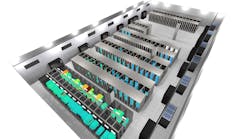The Emerging Contender for Cloud Supremacy
In this week’s Voices of the Industry column, Danielle Hagel, Senior Manager of CoreSite’s customer engagement program, explores who’s in line for cloud supremacy in the market, as well as growing competition.
Danielle Hagel, Senior Manager of CoreSite’s customer engagement program
The cloud industry is booming. The $240 billion-per-year-and-growing global industry would seem, on the surface, to have plenty of room for everyone, but two major players – Amazon Web Services (AWS) and Microsoft – have staked sizable claims in the market and are slowly crowding out competitors.
The two cloud behemoths have generally pursued different target audiences, enabling them to each carve out the leading positions they enjoy today. Having launched nearly four years ahead of Microsoft’s Azure, AWS has enjoyed an advantage in revenue and market share over the second-leading competitor. It has become the preferred solution for smaller organizations just getting started with a cloud environment and for mid- and large enterprises looking at cost-effective methods for running “web scale” applications that support a lot of users. Among the more prominent AWS EC2 subscribers are well-known brands like Expedia and Airbnb, who rely on AWS to support service to customers worldwide.
Meanwhile, Azure has predominantly been the preference of IT pros and app developers because of the platform’s out-of-the-box, intuitive tools. Azure has a slew of app deployment options for developers and great tools in place to easily deploy and scale virtually any app they like. Microsoft’s cloud is also especially helpful for Windows admins in smaller organizations that have virtualized their compute and storage environments, but don’t need to host highly scalable apps.
As the pair continue to maneuver for additional market share and duke it out for market supremacy, it begs the question: Can Microsoft eventually overtake AWS as the cloud leader?
Catching AWS
Microsoft has made great strides in the last couple of years to close the gap with AWS, but is still roughly one-third of the size. Microsoft’s strategy – and path forward to surpassing AWS – is a three-pronged approach comprising data center infrastructure investments, software-as-a-service (SaaS) market dominance, and developer recruitment.
In the past year alone, the company has opened multiple data centers in the UK, the Netherlands, two regions in Korea, and is expected to open more facilities in Texas, Arizona, France and Ireland in the near future. The added capacity means Microsoft will operate approximately twice as many regions globally as AWS. This includes a larger presence in China and offering full data sovereignty in Germany, unlike AWS. These attractive geographic locations allow customers to improve computing power while reducing latency.
The extra computing power, speed and redundancy is essential to achieving SaaS dominance and capitalizing on emerging trends. The SaaS market is expected to remain the second largest segment in the global cloud services market, with more than 50 percent of new 2017 large-enterprise North American application adoptions being SaaS or other forms of cloud-based solutions. Cloud infrastructure growth will also be driven by increased demand for compute-hungry solutions like AI and machine learning platforms. So, investing in data center clusters in a multitude of regions that bring computing, storage, and failover capabilities closer to prospective customers is a smart approach to capturing larger market share and increasing revenues.
The final piece to Microsoft’s puzzle is developer relations. Already the choice of many in the development community, the company’s leadership isn’t shy about promoting emerging open source projects to win business from developers who want the largest possible choice of software and platforms, evidenced by the recent acquisition of Deis, Xamarin, and other strategic targets. Capturing the attention of developer leaders helps Microsoft cast a wider net for its cloud services, enabling more rapid net new customer acquisition and more “land-and-expand” opportunities for growing revenue down the road.
The battle for cloud supremacy is far from over. Despite getting a late start, Microsoft Azure is slowly gaining ground on AWS. It’s an uphill battle, but with smart planning and a commitment to capital investments, it’s entirely possible for Azure to finally catch – and surpass – AWS as the cloud leader. It is exciting to watch what unfolds, as we always root for success with all of our business partners.
Danielle is the Senior Manager of CoreSite’s customer engagement program, and she oversees the go-to-market strategy for cloud partnerships.





